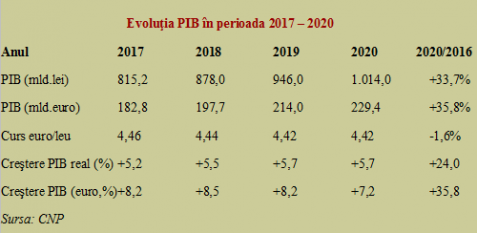 The entire foundation consisting of the indicators forecasted by the National Commission for Prognosis (CNP), an institution reporting to the Government, relies on the assumption of a strengthening domestic currency against euro in four years, between 2017 and 2020. The average exchange rate should be near 4.46 lei/euro in 2017, 4.44 lei/euro in 2018 and 4.42 lei/euro in 2019 and 2020.
The entire foundation consisting of the indicators forecasted by the National Commission for Prognosis (CNP), an institution reporting to the Government, relies on the assumption of a strengthening domestic currency against euro in four years, between 2017 and 2020. The average exchange rate should be near 4.46 lei/euro in 2017, 4.44 lei/euro in 2018 and 4.42 lei/euro in 2019 and 2020.
Unfortunately, the data illustrating the quarterly evolution of the exchange rate in recent years are not encouraging at all about the possibility to achieve this result.
In 2015 and 2016, the annual average euro – leu exchange rate was similar to the level reached in the first two quarters. In the absence of a significant appreciation of the domestic currency in the second quarter of the year, like it happened in 2014, it is unlikely to end the year with the forecasted level of 4.46 lei/euro (see table).
*
- Exchange rate evolution between 2014-2017
- Year Q1 Q2 Q3 Q4 Average
*
Exchange rate influence on GDP and significant impact on convergence
On the contrary, if the tendency of the domestic currency is toward 4.60 lei/euro in the second quarter of this year (just a minor increase of only one percent compared to the current situation), the 2017 GDP result expressed in the European single currency would not be EUR 182.8 billion anymore (see chart), but EUR 178.8 billion, with a potential average exchange rate of 4.56 lei/euro.
*
- GDP evolution between 2017-2020
- Year
- GDP (bn lei)
- GDP (bn euros)
- Leu/eur exchange rate
- Real GDP growth (%)
- Real GDP growth (euro, %)
- Source: INS
*
The idea is not to alarm you unnecessarily; in fact, such variations of the exchange rate are very common in the Western countries. However, their economies are much more stable, can absorb the shocks and have the possibility to offset them.
For Romania, though, a minus of about four billion euros to a relatively modest GDP would not be something with which to play.
The problem is that the entire growth strategy is based on an economic advance much higher in euro than in real terms. More specifically, we can see that there is a major plus of three percent in 2017 and 2018 in the data on which the wage and pension benefits, the tax cuts distribution, etc. are based if converted to euro.
A plus that would diminish, but remain quite significant in 2019 and 2020, which should lead us to an accumulated economic advance of nearly 36% in four years (essential for reducing the disparities with the West) and not just 24%, if we are to make calculations in lei, adjusted to the prices from the base periods.
And so, the provisions on the salary increase between 2017 – 2020 are five percent higher than the economic growth, with an aggregate gross wage growth of more than 40%, unprecedented since the five-year interval 1975 -1980 (when the former dictator insisted on increasing the wages, as promised, despite the damages caused by the earthquake in 1977 and he was forced to borrow and raise the prices afterwards).
… And salaries
*
- Wage evolution between 2017-2020
- Year
- Gross average (lei)
- Net average (lei)
- Source: INS
*
These data regarding the wage increase already prove to be exceeded by the reality of this year start, even before other increases announced and/or requested by increasingly larger categories of employees. Although the average gross wage in 2017 was set to 3.131 lei and the average net wage to 2,274 lei, the official statistics announced a gross wage of 3,168 lei and a net wage of 2,300 lei for the first month.
If we were to take the solidity and consistency of the CNP data seriously, we might wonder in which of the following months of the year the wages are to decrease, so that the targeted average earnings considered for building the 2017 budget to still be maintained.
And we should not forget: big investors in Romania come from the Eurozone, keep their accounts, at the group level, and think in euro. In the absence of productivity increases (given the labour productivity decrease of minus 0.4% in 2016, officially announced late last week by the BNR statistical bulletin 1/2017), they can pay higher salaries only in lei, not euro, if they want to continue to be competitive. With the corresponding implication for the euro/leu exchange rate.












